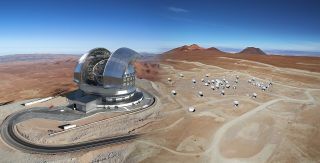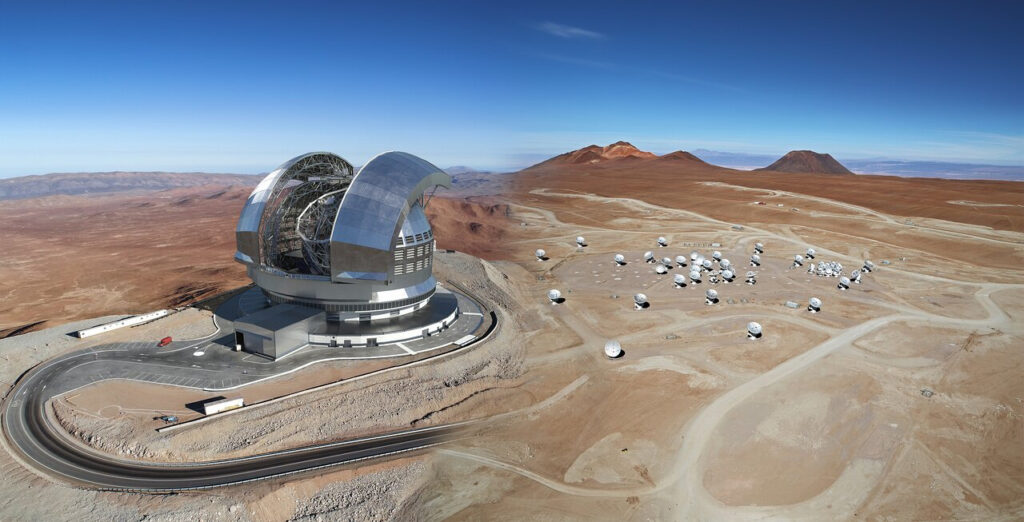
(Image credit: ELT: ESO / Imagen ALMA: Clem & Adri Bacri-Normier (wingsforscience.com) / Montaje: David Fernández – ALMA (ESO/NAOJ/NRAO))
Astronomy has a bright future.
The universe is being revealed in exquisite detail with the current generation of large optical telescopes, reaching back close to the big bang. There’s hope that the mysteries of dark matter and dark energy will be solved. Thousands of exoplanets have been discovered, and astronomers may be closing in on the first detection of life beyond Earth.
However, observations into the cosmic frontier involve extremely faint targets and astronomers are always hungry for more light. In order to keep peering farther into unknown reaches of the universe, the next generation of giant telescopes on the ground and in orbit will each cost billions of dollars. That price tag is leading to a collision between scientific aspirations and fiscal realities.
Related: The 10 biggest telescopes on Earth
The Cost of Big Glass
For most of the history of astronomy until 1980, there was an approximate scaling of telescope cost with mirror diameter, where cost was equal to the telescope’s diameter multiplied to the 2.8 power. That meant if the size doubled, the cost went up by a factor of seven — and if the size tripled, the cost went up by a factor of twenty-two. Many people doubted that a telescope larger than the Palomar 5-meter would ever be built.
In the past four decades, however, telescope costs have gone up at a shallower rate with size, breaking the previous cost curve. The innovations that led to this change were thinner and lighter mirrors, the practice of making a large collecting area from a mosaic of smaller mirrors, using fast optics to enable more compact telescope designs, and shrinking the sizes of telescope enclosures. Thanks to these innovations, sixteen telescopes with diameters between 6 meters and 12 meters were built between 1993 and 2006.
The Quest for Gigantic Telescopes
The next generation of extremely large telescopes will have 100 times the light-gathering power and 10 times the image quality of the Hubble Space Telescope. However, they’re running into serious funding problems. There are two American-led projects with international partners. The Thirty Meter Telescope (TMT) project uses a design with 492 mirror segments. It faces headwinds from the opposition of native Hawaiians to construction of another large telescope on Mauna Kea, which they consider to be a sacred site. Another project, the Giant Magellan Telescope (GMT), is combining seven 8.4-meter mirrors to make an effective 25-meter aperture.
Breaking space news, the latest updates on rocket launches, skywatching events and more!
The TMT project is stalled as it negotiates a way to begin construction in Hawaii. The GMT and another large telescope being built in Chile, the Rubin Observatory, are facing escalating costs. The pandemic, inflation, and supply chain problems are to blame. TMT and GMT will each cost around $3 billion. Both have philanthropic support, but they also rely on federal funding. For a while, the National Science Foundation (NSF) supported both projects. But recently, the National Science Board set a cap of $1.6 billion on federal support for large telescopes and gave the NSF until May to decide which project to support. One large telescope will be left out in the cold.
Meanwhile, the Europeans are sitting pretty. The Extremely Large Telescope (ELT) is a third gigantic telescope, currently under construction in Chile. The ELT doesn’t face financial hurdles since it’s being built by the European Southern Observatory, which is funded by an intergovernmental treaty. At 39-meters in diameter, the ELT is the largest of the three telescopes, and it will be completed first, in 2028.
The Telescope that Ate Astronomy
Space telescopes cost a thousand times more per kilogram than ground-based telescopes, but they’re worth their high price. These telescopes gain the benefit of the total darkness of a space environment, and many forms of radiation that these telescopes can observe such as gamma rays, ultraviolet light, and infrared radiation cannot penetrate the Earth’s atmosphere to reach ground-based telescopes.
One such instrument, the Hubble Space Telescope has run up a total cost of $16 billion since the U.S. Congress approved its mission in 1977. Another, NASA’s James Webb Telescope, faced delays and technical challenges, and its budget ballooned to $5 billion. Its price tag helped it earn the nickname “the telescope that ate astronomy” — and that was in 2010. By the time of its launch in 2021, the price tag had doubled to $10 billion.
NASA has other exciting missions in the pipeline. The Roman Space Telescope, with a 2.4-meter mirror but a hundred times Hubble’s field of view, is likely to cost over $3 billion, and the Habitable Worlds Observatory, designed to “sniff” the atmospheres of Earth-like planets for traces of biology, will come in around $11 billion.
These space telescope missions take a big bite out of a NASA budget that has been declining for twenty years. Just as is the case with the NSF’s budget caps, big capital projects leave less money to spend on other forms of research. But the private sector may come to the rescue. SpaceX’s Starship could be used to launch a 6.5-meter mirror in one piece, avoiding the complicated and expensive folding mirrors used by JSWT. The same innovations used with ground-based telescopes could cut the cost of telescopes in space.
As they face the costs of viewing the distant universe and returning rocks from a nearby planet, astronomers and planetary scientists are being brought back down to Earth with a bump. While it seems to be a golden age for astronomy, the glitter is dimmed by the cost of all that gold and the hard trade-offs that must be made in a time of fiscal austerity.
Join our Space Forums to keep talking space on the latest missions, night sky and more! And if you have a news tip, correction or comment, let us know at: community@space.com.
>>> Read full article>>>
Copyright for syndicated content belongs to the linked Source : Space.com – https://www.space.com/bright-and-expensive-future-of-astronomy
